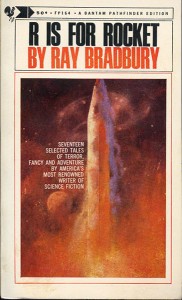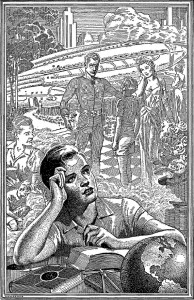 “There was this fence where we pressed our faces and felt the wind turn warm and held to the fence and forgot who we were or where we came from but dreamed of who we might be and where we might go…”
“There was this fence where we pressed our faces and felt the wind turn warm and held to the fence and forgot who we were or where we came from but dreamed of who we might be and where we might go…”
R is for Rocket
Ray Bradbury
In the wake of NASA’s latest advancement in space travel, all of my childhood anxieties have once again risen with anticipation of what the future may hold. This time around, sitting in front of our television with two of my kids, watching the launch of the Exploration Flight Test (EFT-1) with the Orion Multi-Purpose Crew Vehicle aboard the Delta IV Heavy rocket system. The event inspired a Twitter note saying “thank you NASA for scheduling this event at a time my kids could watch before they were off to school.” Because, what better way appreciate our future than with those who will be a part of it.
These moments are few and far between. And its times like this that sends me back to the bookshelf in appreciation of the visions of those who came before us.

Like the characters in Ray Bradbury’s R is for Rocket, we too pressed our faces against the fence and fantasized of our future. The copy I have here is from Bantam’s 6th printing of a collection of short stories by Bradbury appropriately titled R is for Rocket. First published in the December 1943 issue of Famous Fantastic Mysteries, this short story (then under the title King of the Gray Spaces) predicted a future of space wonder through the eyes of the young. Though the original FFM version did not include the fence reference (there are quite a few editorial differences), the story still embodies the same grandeur and awe of possible space travel felt by many members of fandom.
The story has a dystopian sense at first as the reader might get the impression that the future of the young people is controlled by the government. With references of reclassifications by a psych-board, hypnotic suggestion, and psychiatric laundering as tools used by the school administrations in dealing with kids, Bradbury definitely questions the social priorities in our future.

Art by Lawrence Sterne Stevens
But what’s really happening in R is for Rocket is, under the control of something called Providence, the advancement of space travel has taken priority. Is that such a bad thing? Though the Astronaut Board has what seems to be the most influential power, the future still relies on the young. So it makes sense that these most impressionable characters are the ones swayed by the romanticism of space travel.
The caveat here is that you cannot apply to the space program. You are “chosen.” So if you have any inclination to become and astronaut, you must excel in school. And like many aspects of technological advancements today, competition breeds success.
On the note of technology, R is for Rocket does have its time sensitive perspective of an advanced future. Things like para-guns, food-capsules, radiophones, and the new XL3-motor (the FFM version referred to it as the X-tube-jet) are fun elements to make any fan giggle with nostalgic excitement.
Bradbury does resort to a social dialect of an assumed future where young people play with word usage. A lot of the banter has a space theme typical of this type of story, but words like “sick” has a counter meaning, much like today’s use of “bad” meaning something good. It’s not quite on par with the language style of A Clockwork Orange by Anthony Burgess, but it is still noticeable.
There are also a few religious connotations that gives the reader a sense of faith, which is an interesting element considering the rest of the theme. This aspect doesn’t become a distraction from the story, but it does open the forum for possible discussion within fandom.
 Ray Bradbury’s R is for Rocket is a welcomed perspective of future space travel from the eyes of the past. In the shadow of NASA’s Dec 5, 2014 launch of the EFT-1 (right), it’s nice to step back in time and appreciate the same youthful dreams that are experienced today. Because no matter what generation is looking through the fence and dreaming, space matters.
Ray Bradbury’s R is for Rocket is a welcomed perspective of future space travel from the eyes of the past. In the shadow of NASA’s Dec 5, 2014 launch of the EFT-1 (right), it’s nice to step back in time and appreciate the same youthful dreams that are experienced today. Because no matter what generation is looking through the fence and dreaming, space matters.










